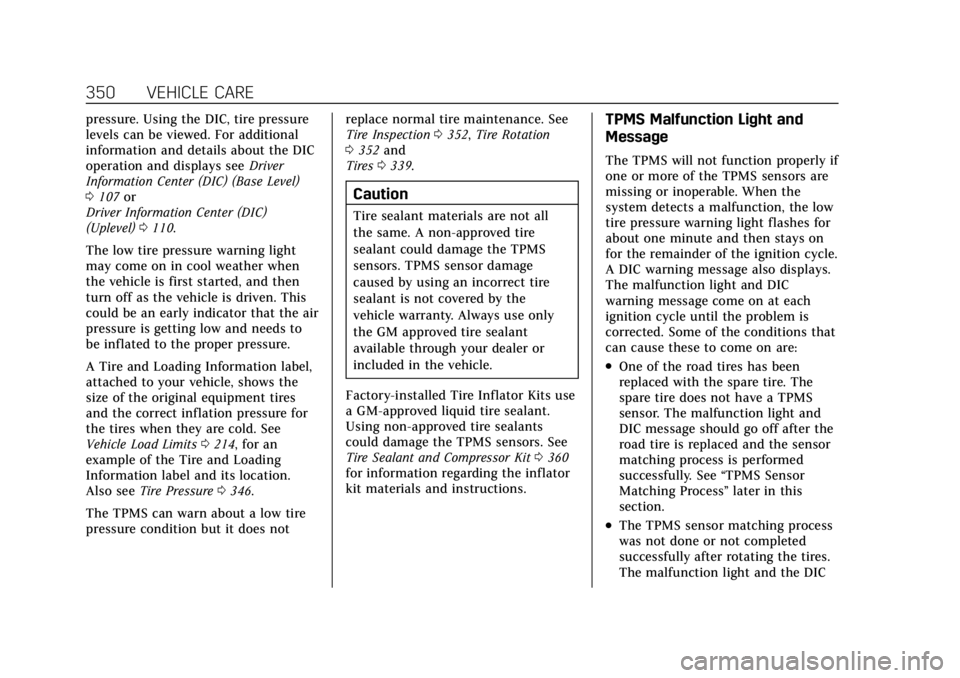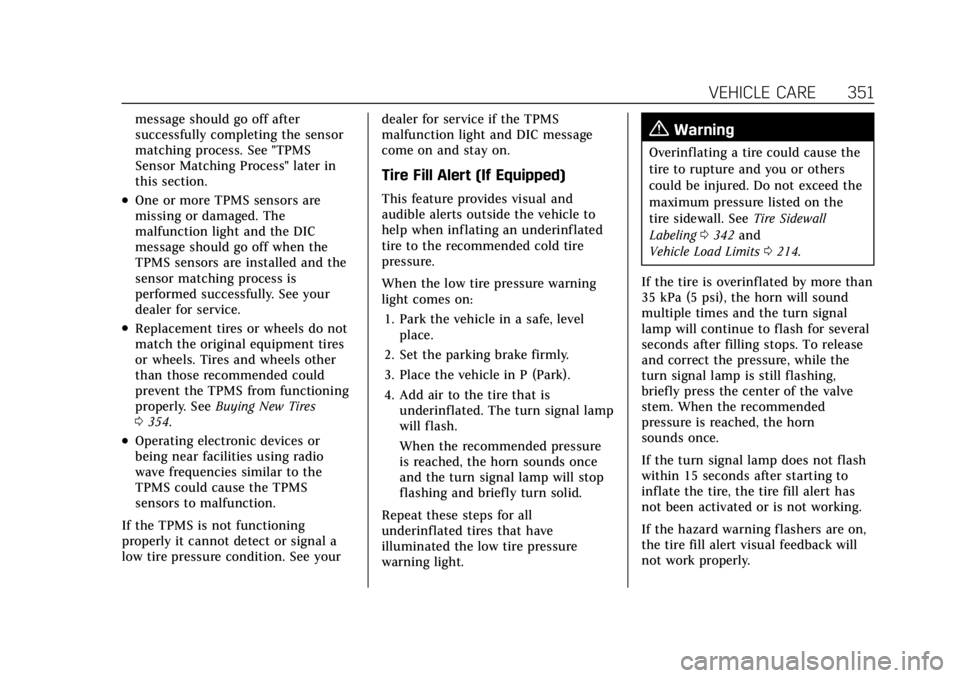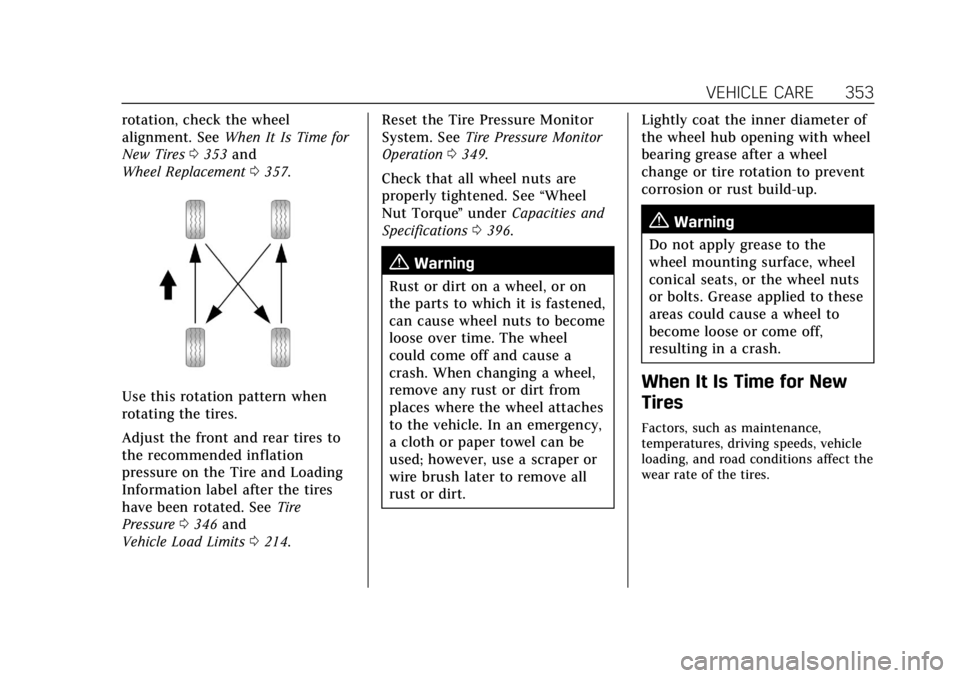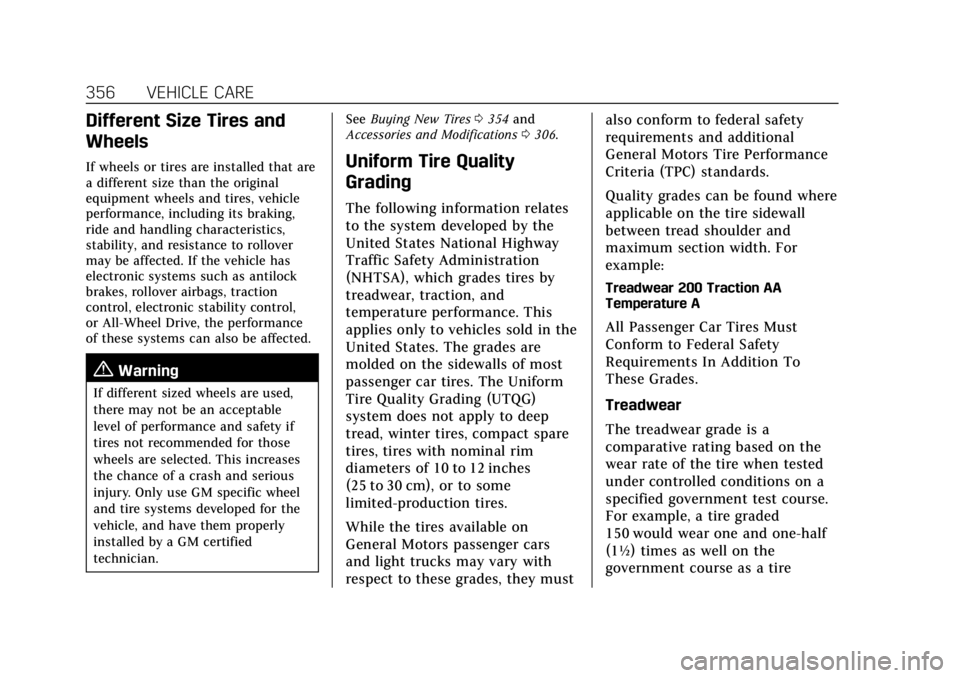warning light CADILLAC CT4 2021 Repair Manual
[x] Cancel search | Manufacturer: CADILLAC, Model Year: 2021, Model line: CT4, Model: CADILLAC CT4 2021Pages: 434, PDF Size: 8.3 MB
Page 351 of 434

Cadillac CT4 Owner Manual (GMNA-Localizing-U.S./Canada-14584335) -
2021 - CRC - 11/23/20
350 VEHICLE CARE
pressure. Using the DIC, tire pressure
levels can be viewed. For additional
information and details about the DIC
operation and displays seeDriver
Information Center (DIC) (Base Level)
0 107 or
Driver Information Center (DIC)
(Uplevel) 0110.
The low tire pressure warning light
may come on in cool weather when
the vehicle is first started, and then
turn off as the vehicle is driven. This
could be an early indicator that the air
pressure is getting low and needs to
be inflated to the proper pressure.
A Tire and Loading Information label,
attached to your vehicle, shows the
size of the original equipment tires
and the correct inflation pressure for
the tires when they are cold. See
Vehicle Load Limits 0214, for an
example of the Tire and Loading
Information label and its location.
Also see Tire Pressure 0346.
The TPMS can warn about a low tire
pressure condition but it does not replace normal tire maintenance. See
Tire Inspection
0352, Tire Rotation
0 352 and
Tires 0339.
Caution
Tire sealant materials are not all
the same. A non-approved tire
sealant could damage the TPMS
sensors. TPMS sensor damage
caused by using an incorrect tire
sealant is not covered by the
vehicle warranty. Always use only
the GM approved tire sealant
available through your dealer or
included in the vehicle.
Factory-installed Tire Inflator Kits use
a GM-approved liquid tire sealant.
Using non-approved tire sealants
could damage the TPMS sensors. See
Tire Sealant and Compressor Kit 0360
for information regarding the inflator
kit materials and instructions.
TPMS Malfunction Light and
Message
The TPMS will not function properly if
one or more of the TPMS sensors are
missing or inoperable. When the
system detects a malfunction, the low
tire pressure warning light flashes for
about one minute and then stays on
for the remainder of the ignition cycle.
A DIC warning message also displays.
The malfunction light and DIC
warning message come on at each
ignition cycle until the problem is
corrected. Some of the conditions that
can cause these to come on are:
.One of the road tires has been
replaced with the spare tire. The
spare tire does not have a TPMS
sensor. The malfunction light and
DIC message should go off after the
road tire is replaced and the sensor
matching process is performed
successfully. See “TPMS Sensor
Matching Process” later in this
section.
.The TPMS sensor matching process
was not done or not completed
successfully after rotating the tires.
The malfunction light and the DIC
Page 352 of 434

Cadillac CT4 Owner Manual (GMNA-Localizing-U.S./Canada-14584335) -
2021 - CRC - 11/23/20
VEHICLE CARE 351
message should go off after
successfully completing the sensor
matching process. See "TPMS
Sensor Matching Process" later in
this section.
.One or more TPMS sensors are
missing or damaged. The
malfunction light and the DIC
message should go off when the
TPMS sensors are installed and the
sensor matching process is
performed successfully. See your
dealer for service.
.Replacement tires or wheels do not
match the original equipment tires
or wheels. Tires and wheels other
than those recommended could
prevent the TPMS from functioning
properly. SeeBuying New Tires
0 354.
.Operating electronic devices or
being near facilities using radio
wave frequencies similar to the
TPMS could cause the TPMS
sensors to malfunction.
If the TPMS is not functioning
properly it cannot detect or signal a
low tire pressure condition. See your dealer for service if the TPMS
malfunction light and DIC message
come on and stay on.
Tire Fill Alert (If Equipped)
This feature provides visual and
audible alerts outside the vehicle to
help when inflating an underinflated
tire to the recommended cold tire
pressure.
When the low tire pressure warning
light comes on:
1. Park the vehicle in a safe, level place.
2. Set the parking brake firmly.
3. Place the vehicle in P (Park).
4. Add air to the tire that is underinflated. The turn signal lamp
will flash.
When the recommended pressure
is reached, the horn sounds once
and the turn signal lamp will stop
flashing and briefly turn solid.
Repeat these steps for all
underinflated tires that have
illuminated the low tire pressure
warning light.
{Warning
Overinflating a tire could cause the
tire to rupture and you or others
could be injured. Do not exceed the
maximum pressure listed on the
tire sidewall. See Tire Sidewall
Labeling 0342 and
Vehicle Load Limits 0214.
If the tire is overinflated by more than
35 kPa (5 psi), the horn will sound
multiple times and the turn signal
lamp will continue to flash for several
seconds after filling stops. To release
and correct the pressure, while the
turn signal lamp is still flashing,
briefly press the center of the valve
stem. When the recommended
pressure is reached, the horn
sounds once.
If the turn signal lamp does not flash
within 15 seconds after starting to
inflate the tire, the tire fill alert has
not been activated or is not working.
If the hazard warning flashers are on,
the tire fill alert visual feedback will
not work properly.
Page 354 of 434

Cadillac CT4 Owner Manual (GMNA-Localizing-U.S./Canada-14584335) -
2021 - CRC - 11/23/20
VEHICLE CARE 353
rotation, check the wheel
alignment. SeeWhen It Is Time for
New Tires 0353 and
Wheel Replacement 0357.
Use this rotation pattern when
rotating the tires.
Adjust the front and rear tires to
the recommended inflation
pressure on the Tire and Loading
Information label after the tires
have been rotated. See Tire
Pressure 0346 and
Vehicle Load Limits 0214. Reset the Tire Pressure Monitor
System. See
Tire Pressure Monitor
Operation 0349.
Check that all wheel nuts are
properly tightened. See “Wheel
Nut Torque ”under Capacities and
Specifications 0396.
{Warning
Rust or dirt on a wheel, or on
the parts to which it is fastened,
can cause wheel nuts to become
loose over time. The wheel
could come off and cause a
crash. When changing a wheel,
remove any rust or dirt from
places where the wheel attaches
to the vehicle. In an emergency,
a cloth or paper towel can be
used; however, use a scraper or
wire brush later to remove all
rust or dirt. Lightly coat the inner diameter of
the wheel hub opening with wheel
bearing grease after a wheel
change or tire rotation to prevent
corrosion or rust build-up.
{Warning
Do not apply grease to the
wheel mounting surface, wheel
conical seats, or the wheel nuts
or bolts. Grease applied to these
areas could cause a wheel to
become loose or come off,
resulting in a crash.
When It Is Time for New
Tires
Factors, such as maintenance,
temperatures, driving speeds, vehicle
loading, and road conditions affect the
wear rate of the tires.
Page 357 of 434

Cadillac CT4 Owner Manual (GMNA-Localizing-U.S./Canada-14584335) -
2021 - CRC - 11/23/20
356 VEHICLE CARE
Different Size Tires and
Wheels
If wheels or tires are installed that are
a different size than the original
equipment wheels and tires, vehicle
performance, including its braking,
ride and handling characteristics,
stability, and resistance to rollover
may be affected. If the vehicle has
electronic systems such as antilock
brakes, rollover airbags, traction
control, electronic stability control,
or All-Wheel Drive, the performance
of these systems can also be affected.
{Warning
If different sized wheels are used,
there may not be an acceptable
level of performance and safety if
tires not recommended for those
wheels are selected. This increases
the chance of a crash and serious
injury. Only use GM specific wheel
and tire systems developed for the
vehicle, and have them properly
installed by a GM certified
technician.See
Buying New Tires 0354 and
Accessories and Modifications 0306.
Uniform Tire Quality
Grading
The following information relates
to the system developed by the
United States National Highway
Traffic Safety Administration
(NHTSA), which grades tires by
treadwear, traction, and
temperature performance. This
applies only to vehicles sold in the
United States. The grades are
molded on the sidewalls of most
passenger car tires. The Uniform
Tire Quality Grading (UTQG)
system does not apply to deep
tread, winter tires, compact spare
tires, tires with nominal rim
diameters of 10 to 12 inches
(25 to 30 cm), or to some
limited-production tires.
While the tires available on
General Motors passenger cars
and light trucks may vary with
respect to these grades, they must also conform to federal safety
requirements and additional
General Motors Tire Performance
Criteria (TPC) standards.
Quality grades can be found where
applicable on the tire sidewall
between tread shoulder and
maximum section width. For
example:
Treadwear 200 Traction AA
Temperature A
All Passenger Car Tires Must
Conform to Federal Safety
Requirements In Addition To
These Grades.
Treadwear
The treadwear grade is a
comparative rating based on the
wear rate of the tire when tested
under controlled conditions on a
specified government test course.
For example, a tire graded
150 would wear one and one-half
(1½) times as well on the
government course as a tire
Page 358 of 434

Cadillac CT4 Owner Manual (GMNA-Localizing-U.S./Canada-14584335) -
2021 - CRC - 11/23/20
VEHICLE CARE 357
graded 100. The relative
performance of tires depends
upon the actual conditions of
their use, however, and may
depart significantly from the norm
due to variations in driving habits,
service practices and differences
in road characteristics and
climate.
Traction
The traction grades, from highest
to lowest, are AA, A, B, and C.
Those grades represent the tire's
ability to stop on wet pavement as
measured under controlled
conditions on specified
government test surfaces of
asphalt and concrete. A tire
marked C may have poor traction
performance. Warning: The
traction grade assigned to this tire
is based on straight-ahead braking
traction tests, and does not
include acceleration, cornering,
hydroplaning, or peak traction
characteristics.Temperature
The temperature grades are A (the
highest), B, and C, representing
the tire's resistance to the
generation of heat and its ability
to dissipate heat when tested
under controlled conditions on a
specified indoor laboratory test
wheel. Sustained high temperature
can cause the material of the tire
to degenerate and reduce tire life,
and excessive temperature can
lead to sudden tire failure. The
grade C corresponds to a level of
performance which all passenger
car tires must meet under the
Federal Motor Safety Standard
No. 109. Grades B and A represent
higher levels of performance on
the laboratory test wheel than the
minimum required by law.
Warning: The temperature grade
for this tire is established for a tire
that is properly inflated and not
overloaded. Excessive speed,
underinflation, or excessive
loading, either separately or in
combination, can cause heat
buildup and possible tire failure.
Wheel Alignment and Tire
Balance
The tires and wheels were aligned and
balanced at the factory to provide the
longest tire life and best overall
performance. Adjustments to wheel
alignment and tire balancing are not
necessary on a regular basis. Consider
an alignment check if there is unusual
tire wear or the vehicle is significantly
pulling to one side or the other. Some
slight pull to the left or right,
depending on the crown of the road
and/or other road surface variations
such as troughs or ruts, is normal.
If the vehicle is vibrating when driving
on a smooth road, the tires and
wheels may need to be rebalanced.
See your dealer for proper diagnosis.
Wheel Replacement
Replace any wheel that is bent,
cracked, or badly rusted or corroded.
If wheel nuts keep coming loose, the
wheel, wheel bolts, and wheel nuts
Page 368 of 434

Cadillac CT4 Owner Manual (GMNA-Localizing-U.S./Canada-14584335) -
2021 - CRC - 11/23/20
VEHICLE CARE 367
2.0L L4 Engine Shown, 2.7L L4 EngineSimilar
1. Discharged Battery Remote
Positive Terminal
2. Discharged Battery Negative Grounding Terminal
3. Good Battery Negative Terminal
4. Good Battery Positive Terminal
The jump start positive terminal (4)
and negative post (3) are on the
battery of the vehicle providing the
jump start. The jump start remote positive
terminal (1) and the remote negative
grounding terminal (2) for the
discharged battery are on the
passenger side of the vehicle.
The positive jump start connection for
the discharged battery is under a
cover. Lift the cover to expose the
terminal.
1. Check the other vehicle. It must have a 12-volt battery with a
negative ground system.
Caution
If the other vehicle does not have a
12-volt system with a negative
ground, both vehicles can be
damaged. Only use a vehicle that
has a 12-volt system with a
negative ground for jump starting.
2. Position the two vehicles so that they are not touching.
3. Set the parking brake firmly and put the shift lever in P (Park) with
an automatic transmission,
or Neutral with a manual
transmission.
Caution
If any accessories are left on or
plugged in during the jump starting
procedure, they could be damaged.
The repairs would not be covered
by the vehicle warranty. Whenever
possible, turn off or unplug all
accessories on either vehicle when
jump starting.
4. Turn the ignition off. Turn off all lights and accessories in both
vehicles, except the hazard warning
flashers if needed.
{Warning
An electric fan can start up even
when the engine is not running and
can injure you. Keep hands,
clothing, and tools away from any
underhood electric fan.
Page 369 of 434

Cadillac CT4 Owner Manual (GMNA-Localizing-U.S./Canada-14584335) -
2021 - CRC - 11/23/20
368 VEHICLE CARE
{Warning
Using a match near a battery can
cause battery gas to explode. People
have been hurt doing this, and
some have been blinded. Use a
flashlight if you need more light.
Battery fluid contains acid that can
burn you. Do not get it on you.
If you accidentally get it in your
eyes or on your skin, flush the place
with water and get medical help
immediately.
{Warning
Fans or other moving engine parts
can injure you badly. Keep your
hands away from moving parts
once the engine is running.
5. Connect one end of the red positive (+) cable to the remote
positive (+) terminal on the
discharged battery. 6. Connect the other end of the red
positive (+) cable to the positive (+)
terminal of the good battery.
7. Connect one end of the black negative (–) cable to the
negative (–) terminal of the good
battery.
Do not let the other end touch
anything until the next step. The
other end of the negative (–) cable
does not go to the dead battery.
It goes to a heavy, unpainted metal
engine part.
8. Connect the other end of the black negative (–) cable to the
negative (–) grounding point for the
discharged battery.
9. Start the engine in the vehicle with the good battery and run the
engine at idle speed for at least
four minutes.
10. Try to start the vehicle that had the dead battery. If it will not start
after a few tries, it probably needs
service.
Caution
If the jumper cables are connected
or removed in the wrong order,
electrical shorting may occur and
damage the vehicle. The repairs
would not be covered by the vehicle
warranty. Always connect and
remove the jumper cables in the
correct order, making sure that the
cables do not touch each other or
other metal.
Jumper Cable Removal
Reverse the sequence exactly when
removing the jumper cables.
After starting the disabled vehicle and
removing the jumper cables, allow it
to idle for several minutes.
Page 422 of 434

Cadillac CT4 Owner Manual (GMNA-Localizing-U.S./Canada-14584335) -
2021 - CRC - 11/23/20
INDEX 421
IndexA
Accessories and Modifications . . . . . 306
Accessory Power . . . . . . . . . . . . . . . . . . . . 223
Adaptive Cruise Control . . . . . . . . . . . . 251
Add-On Electrical Equipment . . . . . . 303
Additional InformationOnStar . . . . . . . . . . . . . . . . . . . . . . . . . . . . . 414
Additional Maintenance and Care . . . . . . . . . . . . . . . . . . . . . . . . . . . 388
Adjustments
Lumbar, Front Seats . . . . . . . . . . . . . . . 32
Thigh Support . . . . . . . . . . . . . . . . . . . . . 33
Agreements Trademarks and License . . . . . . . . . 187
Air Cleaner/Filter, Engine . . . . . . . . . . 316
Air Conditioning . . . . . . . . . . . . . . . . . . . . 196
Air Filter Life System . . . . . . . . . . . . . . . . . . . . . . . . 315
Air Filter, Passenger
Compartment . . . . . . . . . . . . . . . . . . . . . 201
Air Vents . . . . . . . . . . . . . . . . . . . . . . . . . . . . 200
Airbag System Check . . . . . . . . . . . . . . . . . . . . . . . . . . . . . . . 58
How Does an Airbag Restrain? . . . . 52
Passenger Sensing System . . . . . . . . 53
What Makes an AirbagInflate? . . . . . . . . . . . . . . . . . . . . . . . . . . . . 52 Airbag System (cont'd)
What Will You See after an
Airbag Inflates? . . . . . . . . . . . . . . . . . . 52
When Should an Airbag Inflate? . . . . . . . . . . . . . . . . . . . . . . . . . . . . 51
Where Are the Airbags? . . . . . . . . . . . 49
Airbags
Adding Equipment to theVehicle . . . . . . . . . . . . . . . . . . . . . . . . . . . . 58
Passenger Status Indicator . . . . . . . . 96
Readiness Light . . . . . . . . . . . . . . . . . . . . 96
Servicing Airbag-Equipped Vehicles . . . . . . . . . . . . . . . . . . . . . . . . . . . 57
System Check . . . . . . . . . . . . . . . . . . . . . . 48
Alarm Vehicle Security . . . . . . . . . . . . . . . . . . . . 20
Alert Lane Change . . . . . . . . . . . . . . . . . . . . . . 289
Rear Pedestrian . . . . . . . . . . . . . . . . . . . 282
Side Blind Zone (SBZA) . . . . . . . . . . 289
All-Season Tires . . . . . . . . . . . . . . . . . . . . . 339
All-Wheel Drive . . . . . . . . . . . . . . . .236, 327
AM-FM Radio . . . . . . . . . . . . . . . . . . . . . . . 141
Antenna
Multi-band . . . . . . . . . . . . . . . . . . . . . . . . 145
Antilock Brake System (ABS) . . . . . . 236
Warning Light . . . . . . . . . . . . . . . . . . . . 100
Page 423 of 434

Cadillac CT4 Owner Manual (GMNA-Localizing-U.S./Canada-14584335) -
2021 - CRC - 11/23/20
422 INDEX
Appearance CareExterior . . . . . . . . . . . . . . . . . . . . . . . . . . . . 370
Interior . . . . . . . . . . . . . . . . . . . . . . . . . . . . 375
Apple CarPlay and Android Auto . . . . . . . . . . . . . . . . . . . . . . 174
Assistance Systems for Driving . . . . 283
Assistance Systems for Parking and Backing . . . . . . . . . . . . . . . . . . . . . . . 277
Audio Bluetooth . . . . . . . . . . . . . . . . . . . . . . . . . . 148
Auto Stop
Stop/Start System . . . . . . . . . . . . . . . . 221
Automatic Dimming Mirrors . . . . . . . . . . . . . . . . . . 25
Door Locks . . . . . . . . . . . . . . . . . . . . . . . . . 17
Emergency Braking (AEB) . . . . . . . . 285
Headlamp System . . . . . . . . . . . . . . . . 128
Transmission . . . . . . . . . . . . . . . . 227, 229
Transmission Fluid . . . . . . . . . . . . . . . 315
Vehicle Hold Light . . . . . . . . . . . . . . . . 101
Automatic Transmission
Manual Mode . . . . . . . . . . . . . . . 234, 235
Automatic Vehicle Hold (AVH) . . . . 239
Avoiding Untrusted Media Devices . . . . . . . . . . . . . . . . . . . . . . . . . . . . . 145B
Battery
Exterior Lighting BatterySaver . . . . . . . . . . . . . . . . . . . . . . . . . . . . . 133
Load Management . . . . . . . . . . . . . . . . 132
Power Protection . . . . . . . . . . . . . . . . . . 133
Battery - North America . . . . . .326, 366
Blade Replacement, Wiper . . . . . . . . . 327
Bluetooth Overview . . . . . . . . . . . . . . . . . . . . 169, 170
Bluetooth Audio . . . . . . . . . . . . . . . . . . . . 148
Brake Electric Boost . . . . . . . . . . . . . . . . . . . . . 236
Parking, Electric . . . . . . . . . . . . . . . . . . 237
System Warning Light . . . . . . . . . . . . . 99
Brake Pad Life System . . . . . . . . . . . . . . 324
Brakes . . . . . . . . . . . . . . . . . . . . . . . . . . . . . . . 323 Antilock . . . . . . . . . . . . . . . . . . . . . . . . . . . 236
Assist . . . . . . . . . . . . . . . . . . . . . . . . . . . . . . 238
Fluid . . . . . . . . . . . . . . . . . . . . . . . . . . . . . . . 325
Pad Life System . . . . . . . . . . . . . . . . . . . 324
Braking . . . . . . . . . . . . . . . . . . . . . . . . . . . . . . 204 Automatic Emergency (AEB) . . . . . 285
Braking System
Front Pedestrian (FPB) . . . . . . . . . . . 287
Break-In, New Vehicle . . . . . . . . . . . . . . 218
Buckle To Drive . . . . . . . . . . . . . . . . . . . . . . 41 Bulb Replacement
Front Turn Signal Lamps . . . . . . . . 330
Halogen Bulbs . . . . . . . . . . . . . . . . . . . . 330
Headlamp Aiming . . . . . . . . . . . . . . . . 329
Headlamps . . . . . . . . . . . . . . . . . . . . . . . . 329
High Intensity Discharge(HID) Lighting . . . . . . . . . . . . . . . . . . . 330
Buying New Tires . . . . . . . . . . . . . . . . . . . 354
C
Calibration . . . . . . . . . . . . . . . . . . . . . . . . . . . 84
California Perchlorate MaterialsRequirements . . . . . . . . . . . . . . . . . . . 306
California Proposition 65 Warning . . . . . . . . . . . . .305, 326, 366, Back Cover
Canadian Vehicle Owners . . . . . . . . . . . . . 1
Capacities and Specifications . . . . . . 396
Carbon Monoxide Engine Exhaust . . . . . . . . . . . . . . . . . . . 226
Trunk . . . . . . . . . . . . . . . . . . . . . . . . . . . . . . . 19
Winter Driving . . . . . . . . . . . . . . . . . . . . 213
Cargo Management System . . . . . . . . . . . . . . 80
Tie-Downs . . . . . . . . . . . . . . . . . . . . . . . . . . 80
Caution, Danger, and Warning . . . . . . . . 2
Center Console Storage . . . . . . . . . . . . . . 79
Page 424 of 434

Cadillac CT4 Owner Manual (GMNA-Localizing-U.S./Canada-14584335) -
2021 - CRC - 11/23/20
INDEX 423
Chains, Tire . . . . . . . . . . . . . . . . . . . . . . . . . 358
ChargingWireless . . . . . . . . . . . . . . . . . . . . . . . . . . . . 85
Charging System Light . . . . . . . . . . . . . . 97
Check Engine Light (MalfunctionIndicator) . . . . . . . . . . . . . . . . . . . . . . . . . 97
Child Restraints Infants and Young Children . . . . . . . 60
Lower Anchors and Tethersfor Children . . . . . . . . . . . . . . . . . . . . . . . 65
Older Children . . . . . . . . . . . . . . . . . . . . . 59
Securing . . . . . . . . . . . . . . . . . . . . . . . . 72, 74
Systems . . . . . . . . . . . . . . . . . . . . . . . . . . . . 63
Circuit Breakers . . . . . . . . . . . . . . . . . . . . . 331
Cleaning Exterior Care . . . . . . . . . . . . . . . . . . . . . . 370
Interior Care . . . . . . . . . . . . . . . . . . . . . . 375
Climate Control Systems Dual Automatic . . . . . . . . . . . . . . . . . . . 196
Clock . . . . . . . . . . . . . . . . . . . . . . . . . . . . . . . . . . 84
Cluster, Instrument . . . . . . . . . . . . . . 88, 90
Collision Damage Repair . . . . . . . . . . . 406
Compartments Storage . . . . . . . . . . . . . . . . . . . . . . . . . . . . . 78
Compass . . . . . . . . . . . . . . . . . . . . . . . . . . . . . . 84
Competitive Driving Mode . . . . . . . . . 246
Composite Materials . . . . . . . . . . . . . . . . 218 Compressor Kit, Tire Sealant . . . . . . . 360
Connected Services
Connections . . . . . . . . . . . . . . . . . . . . . . . 419
Diagnostics . . . . . . . . . . . . . . . . . . . . . . . . 420
Navigation . . . . . . . . . . . . . . . . . . . . . . . . . 418
Connections Connected Services . . . . . . . . . . . . . . . 419
Control Traction and ElectronicStability . . . . . . . . . . . . . . . . . . . . . . . . . . 239
Control of a Vehicle . . . . . . . . . . . . . . . . 204
Controls
Steering Wheel . . . . . . . . . . . . . . . . . . . . 137
Convex Mirrors . . . . . . . . . . . . . . . . . . . . . . 23
Coolant Engine Temperature Gauge . . . 94, 95
Engine Temperature Warning
Light . . . . . . . . . . . . . . . . . . . . . . . . . . . . . 103
Cooling . . . . . . . . . . . . . . . . . . . . . . . . . . . . . . 196
Cooling System . . . . . . . . . . . . . . . . . . . . . 317
Cornering Lamps . . . . . . . . . . . . . . . . . . . 130
Courtesy Lamps . . . . . . . . . . . . . . . . . . . . . 130
Courtesy Transportation Program . . . . . . . . . . . . . . . . . . . . . . . . . . . . 405
Coverage Explanations . . . . . . . . . . . . . 163
Cruise Control . . . . . . . . . . . . . . . . . . . . . . . 248
Light . . . . . . . . . . . . . . . . . . . . . . . . . . . . . . . 106
Cruise Control, Adaptive . . . . . . . . . . . 251 Cruise Control, Super . . . . . . . . . . . . . . . 260
Cupholders . . . . . . . . . . . . . . . . . . . . . . . . . . . 78
Customer Assistance . . . . . . . . . . . . . . . 402
Offices . . . . . . . . . . . . . . . . . . . . . . . . . . . . . 401
Text Telephone (TTY) Users . . . . . 402
Customer Information Publications Ordering
Information . . . . . . . . . . . . . . . . . . . . . . 408
Customer Satisfaction Procedure . . . . . . . . . . . . . . . . . . . . . . . . . . 399
Cybersecurity . . . . . . . . . . . . . . . . . . . . . . . . 410
D
Damage Repair, Collision . . . . . . . . . . . 406
Danger, Warning, and Caution . . . . . . . . 2
Data Collection Infotainment System . . . . . . . . . . . . . 412
OnStar . . . . . . . . . . . . . . . . . . . . . . . . . . . . . 412
Data Recorders, Event . . . . . . . . . . . . . . 411
Database Coverage Explanations . . . . . . . . . . . . . . . . . . . . . . 163
Daytime Running Lamps (DRL) . . . 128
Defensive Driving . . . . . . . . . . . . . . . . . . . 204
Delayed Locking . . . . . . . . . . . . . . . . . . . . . 17
Destination . . . . . . . . . . . . . . . . . . . . . . . . . . 155
Diagnostics Connected Services . . . . . . . . . . . . . . . 420
Differential, Limited-Slip . . . . . . . . . . . 248